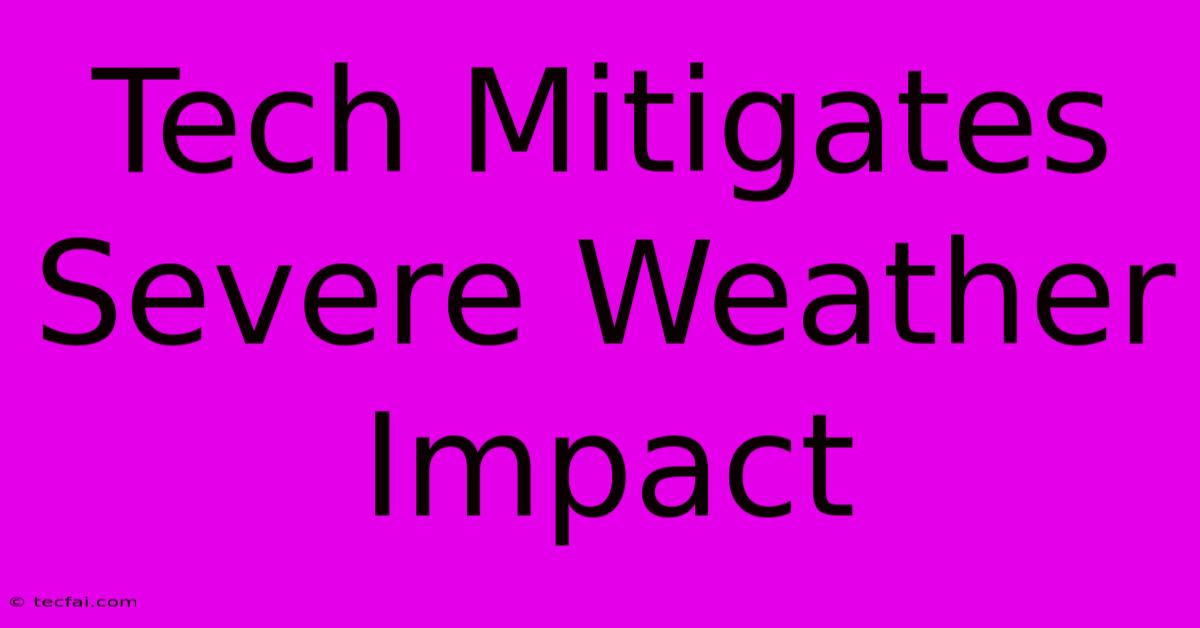Tech Mitigates Severe Weather Impact

Discover more detailed and exciting information on our website. Click the link below to start your adventure: Visit Best Website tecfai.com. Don't miss out!
Table of Contents
Tech Mitigates Severe Weather Impact: A Shield Against Nature's Fury
The power of nature is undeniable, and its wrath in the form of severe weather events is a stark reminder of humanity's vulnerability. From hurricanes and tornadoes to floods and wildfires, these natural disasters can wreak havoc on communities, disrupting lives and leaving lasting scars. However, advancements in technology are playing a vital role in mitigating the impact of these events, offering a much-needed shield against nature's fury.
Early Warning Systems: Giving Time to Prepare
One of the most significant advancements in weather forecasting is the development of sophisticated early warning systems. Using a combination of satellite imagery, radar technology, and weather modeling, these systems provide timely and accurate predictions of impending severe weather events. This valuable information gives communities crucial time to prepare, allowing for evacuations, securing property, and activating emergency response plans.
Examples:
- NOAA's National Weather Service utilizes Doppler radar and other technologies to track storms and issue warnings for tornadoes, hurricanes, and severe thunderstorms.
- The European Centre for Medium-Range Weather Forecasts (ECMWF) provides global weather predictions, which are utilized by national weather services worldwide to improve their forecasts.
Smart Infrastructure: Building Resilience
As climate change intensifies, it's becoming increasingly important to build infrastructure that can withstand the onslaught of extreme weather. Smart infrastructure incorporates technology to enhance its resilience, minimizing damage and improving response capabilities.
Here are some examples:
- Smart sensors can monitor real-time conditions in bridges, dams, and other infrastructure, detecting potential problems and triggering alerts.
- Smart grids can automatically reroute power in case of outages, minimizing disruption to essential services.
- Flood control systems equipped with sensors and automated pumps can respond to flooding more effectively, reducing damage and protecting lives.
Communication Technology: Staying Connected
In the midst of a disaster, maintaining effective communication is crucial for coordination, rescue efforts, and the dissemination of vital information. Mobile communication technologies are revolutionizing how communities respond to and recover from severe weather events.
Here's how:
- Mobile apps like WeatherBug and AccuWeather provide real-time updates on severe weather events, allowing people to stay informed and make informed decisions.
- Social media platforms are used to share information, coordinate relief efforts, and connect with loved ones during emergencies.
- Satellites and drone technology can provide critical communications infrastructure in areas where traditional networks are down.
Data Analytics: Leveraging Information for Better Outcomes
Vast amounts of data are collected during and after severe weather events. This data, when analyzed using sophisticated algorithms, can provide insights that help in disaster preparedness, mitigation, and recovery.
Examples:
- Predictive modeling can use historical data to identify areas at high risk for future events, allowing for targeted prevention efforts.
- Data visualization can help visualize the impact of disasters, enabling better understanding of the scale of damage and the needs of affected communities.
- Machine learning algorithms can analyze real-time data from sensors and social media to track the spread of a disaster and provide valuable information to emergency responders.
The Future of Weather Mitigation: A Collaborative Approach
While technological advancements offer immense potential, effectively mitigating the impact of severe weather requires a collaborative approach. Governments, researchers, and private sector companies must work together to develop and deploy these technologies, ensuring they are accessible to all communities.
By investing in these technological solutions, we can create a future where the impact of severe weather is minimized, and communities are better equipped to withstand nature's fury.

Thank you for visiting our website wich cover about Tech Mitigates Severe Weather Impact. We hope the information provided has been useful to you. Feel free to contact us if you have any questions or need further assistance. See you next time and dont miss to bookmark.
Featured Posts
-
Morning Headlines Your Daily News Digest
Nov 06, 2024
-
Musk Trump Election Night Plans Revealed
Nov 06, 2024
-
Man City Vs Sporting Champions League Live Stream
Nov 06, 2024
-
Steelers Trade For Wr Mike Williams De
Nov 06, 2024
-
In Memoriam Bernie Marcus Philanthropist
Nov 06, 2024
